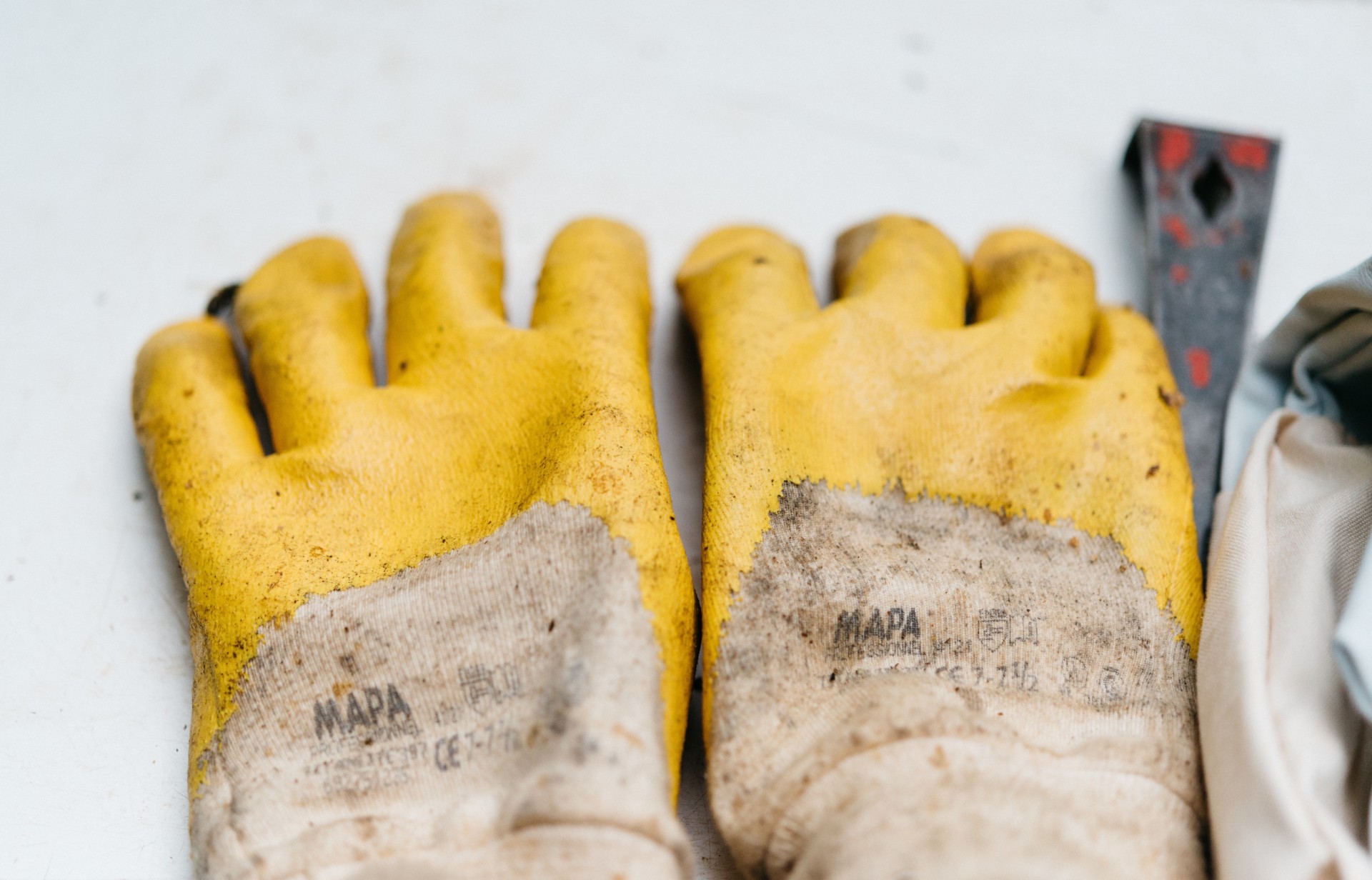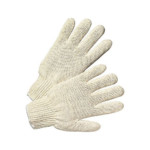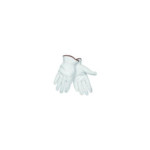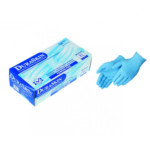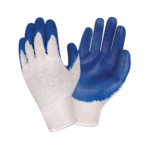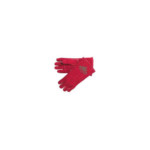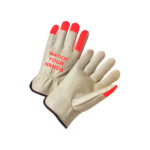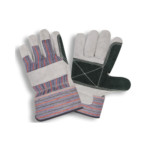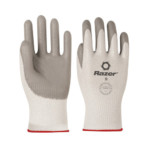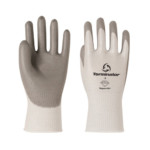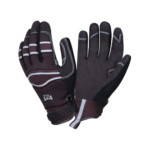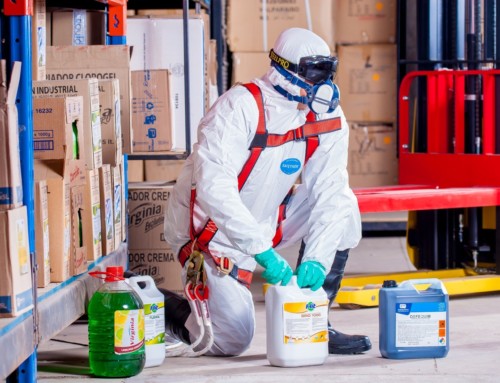The most important question to ask before purchasing safety gloves is: “what am I trying to protect against?” Whether it is minor cuts and blisters or extreme temperatures and chemical exposure, we can help you find exactly what you need to protect you and your workers.
Always be aware of what hand protection your crew is required to have on the job. Always know if you have to deal with cut resistance, chemicals or general purpose. Once you know this, check out the specifics of the tasks that the gloves will be used for.
Different types of safety gloves are made up of different types of material, each better for different types of work.
| Protect Against | Types of Gloves | |||
|---|---|---|---|---|
| General Purpose: Minor Abraisions, Dirt, Chafing | Cotton and Fabric Gloves | Goatskin Gloves | Synthetic Leather Gloves | Nitrile Gloves |
| Slipping | Coated Fabric Gloves | |||
| Welding, Moderate Heat and Flame | Leather Gloves | Goatskin Gloves | Hot Mill Gloves | Kevlar Gloves |
| Cut Resistant | Dyneema Gloves | Dynamax Gloves | Kevlar Gloves | |
| Chemical Liquids | Latex water solutions of acids, alkalis, salts and keytones | Neoprene hydraulic fluids, gasoline, alcohols, organic acids and alkalis | Nitrile chlorinated solvants such as trichloroethylene and perchloroethylene, oils, greases, acids, caustics and alcohols | Fabric Coated Gloves can offer some protection against chemicals depending on what glove is coated in |
General Purpose and Slip Resistant Gloves
General purpose gloves can be one-time use gloves or a more durable, reusable type of glove.
Canvas and fabric gloves are great for moving boxes, preventing blisters, splinters, and light abrasions. However, they should not be used for sharp materials.
Coated fabric gloves can be used in the same way as canvas and fabric gloves. They are a great general purpose glove, offering more slip resistance, will help with some puncture resistance and greater durability than their uncoated cousins.
Goatskin and Synthetic Leather gloves offer better protection against splinters. Each kind of leather glove offers great dexterity and flexibility, although synthetic leather allows for better breathability and higher durability.
Nitrile gloves are often used as a Latex glove replacement. Due to allergy issues with Latex, many worksites have switched to Nitrile gloves. These gloves are made to feel and look similar to Latex but last much longer. Nitrile gloves are three times more puncture resistant than Latex and more cost-effective. Nitrile is often combined with other fabrics to create stronger, more durable and cut resistant gloves.
Welding, Moderate Heat and Flame Gloves
Goatskin gloves make excellent welding gloves due to their lightweight flexibility, in addition to heat, weather and oil resistance.
Synthetic Leather gloves offer better breathability than goatskin leather but provide the same lightweight flexibility, heat and weather resistance. Synthetic leather is also machine washable, oil and grease repellant.
Hot Mill gloves can be double or triple layered gloves that provide a long wear life and heat protection of up to 400 degrees. How high a temperature the glove can withstand will depend on if it is double or triple layered. These gloves are great for glass or ceramic plants, forging or foundry operations.
Kevlar gloves are made from a combination of terry knit, carbon fibers and stainless steel. Kevlar gloves can withstand up to 800 degrees and are flame and cut resistant. These gloves are one of the most durable types of heat resistant gloves because they offer cut resistance and a long wear life.
Cut Resistant Gloves
Cut resistant gloves come in many different varieties and purchasing the “best” ones will depend on the environment your workers are in and what they need cut protection from.
A few questions to ask before buying gloves are:
- Is the edge your glove is coming in contact with on the job. How sharp?
- Does it have a jagged edge?
- What is the product made of?
TIP: Always edge test the gloves you want to use to make sure they will handle the process.
Cut resistant gloves are rated at different levels based on their tensile strength. Tensile strength is very important in determining the glove you need to use. Although different materials are stronger than others, it is in many cases how the fibers are woven. Banom, one of the industry leaders in cut resistant gloves, has perfected the cut resistance process.
Dyneema and Dynamax gloves can handle sheet metal, electrical assembly, drywall, glass materials, sheet metal, and other rough metals. Two of the most popular gloves are the Banom Terminator Glove and the Razer May-Ply Dyneema Glove.
Synthetic Leather and Goatskin gloves can offer some level of cut resistance, however, they are not rated for cut resistance. If your crew needs a little more than a one-time fabric or canvas glove, leather gloves provide a better level of protection and more movability while offering better protection against abrasion.
Chemical Liquid Gloves
Much like cut resistant gloves, which type of chemical protection you need depends on the type of chemicals you’re working with. Ask your safety specialist, as they should have a chart to help you determine which gloves should work for the process.
TIP: Always test your gloves with the chemical you are about to use by placing the glove in the chemical for up to three times as long as you would use it in the normal process. If the glove has not created any holes or expanded in any way, you should be good to go.
Make the Right Choice
Knowing what your worksite crew handles every day will help you determine what gloves would best suit their needs. If you have specific questions or just want more information about personal protective gear, contact us today.


